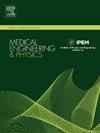Aortic strain, flow pattern and wall shear stress in a patient-specific compliant aorta replica using Shake-the-Box
IF 1.7
4区 医学
Q3 ENGINEERING, BIOMEDICAL
引用次数: 0
Abstract
High-fidelity in vitro flow simulator in combination with high-dimensional flow visualization techniques can offer precise and comprehensive evaluation of aortic hemodynamics. However, it is particularly challenging to create a fully transparent aorta replica that faithfully mimics the aortic curvature and stiffness. In this study, we successfully manufactured a patient-specific compliant aorta phantom with a dilated ascending aorta that can be used in vitro hemodynamic study. We conducted pulsatile flow measurement on the deformable aorta replica using advanced 4D particle tracking velocimetry – Shake-the-Box. The aortic distensibility, circumferential strain, flow pattern, wall shear stress (WSS), and turbulent kinetic energy were assessed. Furthermore, the peak velocity field and WSS distribution were compared to in vivo MRI measurements. We found that the distensibility and circumferential strain of our aortic replica fell within the physiological range of young patients. The aortic diameter changed as much as 5.4 mm (42 %) in a cardiac cycle and the aortic distensibility was 9.9 × 10–3 mmHg-1. In addition, the obtained flow pattern and WSS distribution were found in a good agreement with in vivo MRI measurement. In conclusion, the compliant aorta phantom replicated the aortic wall material well. It also faithfully simulated the aortic flow and near-wall hemodynamics. The relatively large lumen dimension change (5.4 mm) in a cardiac cycle suggests the necessity of considering wall deformation in aortic flow simulations. We propose employing this approach for future studies, such as medical treatment training, validation of in silico fluid-structure interaction models, or as a complement to in vivo measurements.
主动脉应变,流动模式和壁剪切应力在患者特定的顺应主动脉复制品使用摇盒
高保真度体外血流模拟器结合高维血流可视化技术可以对主动脉血流动力学进行精确、全面的评价。然而,创造一个完全透明的主动脉复制品,忠实地模仿主动脉弯曲和硬度,是特别具有挑战性的。在这项研究中,我们成功地制造了一个具有扩张升主动脉的患者特异性顺应性主动脉假体,可用于体外血流动力学研究。我们使用先进的四维粒子跟踪测速仪- Shake-the-Box对可变形主动脉复制品进行脉动流量测量。评估主动脉膨胀性、周向应变、流型、壁剪切应力(WSS)和湍流动能。此外,将峰值速度场和WSS分布与体内MRI测量结果进行比较。我们发现我们的主动脉复制品的扩张性和周应变都在年轻患者的生理范围内。主动脉直径在一个心动周期内变化高达5.4 mm(42%),主动脉扩张率为9.9 × 10-3 mmHg-1。此外,所获得的血流模式和WSS分布与体内MRI测量结果吻合良好。综上所述,柔顺型主动脉假体能很好地复制主动脉壁材料。它还忠实地模拟了主动脉血流和近壁血流动力学。一个心动周期内相对较大的管腔尺寸变化(5.4 mm)提示在主动脉流模拟中考虑管壁变形的必要性。我们建议在未来的研究中采用这种方法,如医学治疗培训、计算机流固相互作用模型的验证,或作为体内测量的补充。
本文章由计算机程序翻译,如有差异,请以英文原文为准。
求助全文
约1分钟内获得全文
求助全文
来源期刊

Medical Engineering & Physics
工程技术-工程:生物医学
CiteScore
4.30
自引率
4.50%
发文量
172
审稿时长
3.0 months
期刊介绍:
Medical Engineering & Physics provides a forum for the publication of the latest developments in biomedical engineering, and reflects the essential multidisciplinary nature of the subject. The journal publishes in-depth critical reviews, scientific papers and technical notes. Our focus encompasses the application of the basic principles of physics and engineering to the development of medical devices and technology, with the ultimate aim of producing improvements in the quality of health care.Topics covered include biomechanics, biomaterials, mechanobiology, rehabilitation engineering, biomedical signal processing and medical device development. Medical Engineering & Physics aims to keep both engineers and clinicians abreast of the latest applications of technology to health care.
 求助内容:
求助内容: 应助结果提醒方式:
应助结果提醒方式:


